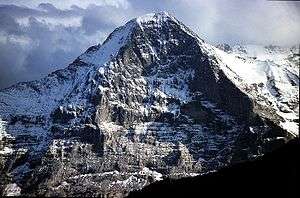Great north faces of the Alps

In mountaineering, the six great North faces of the Alps (also called the six 'classic north faces') are known for their difficulty and great height. A Face is "a vertical or sloping side of a mountain or cliff."[1]
They are (sorted by date of first ascent, last victory first):
- Grandes Jorasses, first ascent in August 1938, making it the very last of the great North faces to be climbed;
- Eiger, first ascent in July 1938;
- Piz Badile, first ascent July 1937;
- Petit Dru, first ascent in 1935;
- Cima Grande di Lavaredo, first ascent in 1933;
- Matterhorn, first ascent in August 1931, making it the first great North face to be climbed.
Making the first ascent of each of these six faces was a major preoccupation of the best European climbers in the 1930s. Gaston Rébuffat, a French alpinist and mountain guide, was the first to climb all six of them, and his 1954 work, Etoiles et Tempêtes (Starlight and Storm), chronicles these climbs.[2]
Three of these north faces—the Eiger, the Matterhorn and the Grandes Jorasses—are considerably harder to climb than the others. This led to their becoming known as 'the Trilogy'. The first to climb these three faces within a year was the Austrian Leo Schlömmer, from the summer of 1961 to the summer of 1962. Ivano Ghirardini was the first man to climb the Trilogy in winter, solo (1977-78), and Catherine Destivelle was the first woman (1992-93-94).[3] With the introduction of the concept of enchainment, the next challenge was to climb all three faces in one outing, a race eventually won by Christophe Profit, who achieved the feat between 11–12 March 1987 in a time of 24 hours.[4]
Gallery
 The North face of the Eiger
The North face of the Eiger The North face of the Grandes Jorasses
The North face of the Grandes Jorasses The North face of the Matterhorn
The North face of the Matterhorn The north-east face of Piz Badile
The north-east face of Piz Badile The North face of the Petit Dru with the ice-field of 'the Niche' clearly visible
The North face of the Petit Dru with the ice-field of 'the Niche' clearly visible- The North face of Cima Grande di Lavaredo
Bibliography
- Anker, Daniel (ed.) (2000) Eiger: The Vertical Arena. Seattle: The Mountaineers.
- Bonatti, Walter (2001). The Mountains of My Life. New York: Modern Library. ISBN 0-375-75640-X.
- Hargreaves, Alison (1995). A Hard Day's Summer: Six Classic North Faces Solo. London: Hodder & Stoughton. ISBN 0-340-60602-9
- Rébuffat, Gaston (1999). Starlight and Storm: The Conquest of the Great North Faces of the Alps. New York: Modern Library. ISBN 0-375-75506-3
References
- ↑ "face - definition of face in English | Oxford Dictionaries 2.2". Oxford Dictionaries | English. Retrieved 2017-04-30.
- ↑ Rébuffat, Gaston (1999). Starlight and Storm: The Conquest of the Great North Faces of the Alps. New York: Modern Library. ISBN 0-375-75506-3.
- ↑ Destivelle, Catherine (2003). "L'Eiger en solitaire et en hiver". Ascensions. Arthaud. p. 181. ISBN 2-7003-9594-8.
- ↑ Mark Twight, Kiss Or Kill: Confessions of a Serial Climber, The Mountaineers Books, 2002, p. 33